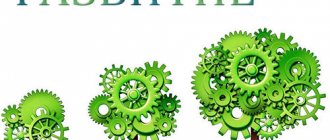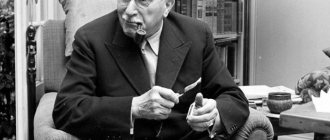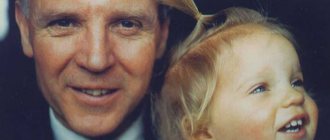Let's find out what factors influence personality development?
From the first minute of life, a person faces difficulties - he has to adapt to new environmental conditions, he learns to contact others and at the same time receive the most necessary things - food, care, warmth. Even then the baby begins to act to achieve something very important to him.
The driving forces of personal development are the contradictions that a person has to resolve on the way to achieving harmony between internal needs and what the external environment, society, and real opportunities offer. These contradictions create motivation, force you to master skills, communicate, learn to react correctly to failures and achieve your plans.
Concept of personality
In psychology, the definition of “personality” means a complex that includes the social qualities of a person, a set of his life and social values. The concept of “personality” also includes the ability to use emerging contradictions between needs and reality for further development.
Personality and individual are not the same thing. If an individual is a set of qualities possessed by a representative of the biological species “Homo sapiens,” then personality is a narrow concept. It is associated with a higher level of development, the presence of a clear system of relationships with other people, and events occurring in the outside world. A person builds his own understanding of what is important to him, what is acceptable and unacceptable, and defines for himself the concepts of “meaning” and “value”.
The extent to which an individual can realize his own principles depends on the presence and development of:
- intelligence;
- talent;
- knowledge skills;
- ability to make efforts (volitional qualities);
- ability to cope with emotions;
- physical data.
The process of personality formation lasts throughout life. The basis for the development of abilities is heredity and the social environment.
Depending on how developed the ability to effectively communicate with others and solve pressing problems, two personality types are distinguished:
- socialized - able to survive in society;
- unsocialized - incapable of social communication, performing assigned social functions, often with mental disabilities.
Distinctive qualities of a socialized personality:
guidance on one’s own goals, values, life strategy even in difficult situations;
- autonomy;
- the ability to use protective techniques to establish a barrier to toxic exposure;
- the ability to establish friendly relationships and make friends;
- the ability to show compassion;
- persistence in achieving goals.
The extent to which a person is socialized and developed is the main indicator of mental well-being and the ability to take responsibility.
Development of Personal Characteristics
Innate qualities determine how capable a person is of diversified development. Throughout life, the natural characteristics of a person remain practically unchanged, only some of them change due to the influence of environmental factors and society.
The time that determines in which direction a personality will develop is the first 5 years of life. In all subsequent years, only some characteristics are added to the existing character structure or existing ones are slightly adjusted.
Personality characteristics influence all areas of a person's life. They affect the style of behavior among relatives, friends, and colleagues, and determine the choice of profession and style of behavior in different situations.
Thus, for a person striving for career success, the driving force is his ability to take a sober look at the existing situation, evaluate his strengths, and ability to achieve his goal. The one who understands his needs, is aware of his own interests and value, will choose an activity that will help to fully reveal his potential.
Communication plays a big role in the development of personal characteristics. It begins from the first minutes of the baby’s birth. In addition to the child, parents, relatives, educators, and other children are involved in the communication process. Through active communication with others, a little person learns to interact with others.
By communicating with others, the child finds motivation, determines the style of behavior in different situations, and determines the most effective tools for interacting with others.
Problems of formation of the motivational sphere
In this chapter we will try to consider those factors that, in our opinion, interfere with the formation of the motivational sphere of the individual. One of the most important is the “desire to avoid failure.”
If we consider any human environment, be it educational, professional, family and many others, we can see that, for example, in families where parents ignore or are indifferent to their children, or are directive in their care and strict in their control, children As a rule, the desire to avoid failure dominates, and as a result, a low level of motivation is formed in general. In the same way, for example, in professional activities, excessive goals set by superiors force subordinates to look for the simplest solutions instead of finding effective solutions. Employees lose high motivation to complete a task because they may be deprived of bonuses or reprimanded, which leads to an “eagerness to avoid mistakes.” The same thing happens in all other areas of human activity.
As for internal motivation, it begins with an internal desire to achieve a goal. Intrinsic motivation is influenced more by emotions, feelings and motives than needs than extrinsic motivation.
Let's consider the problem of motivation in professional activity.
- Little experience, a lot of enthusiasm (low qualifications, high motivation). This could be a young employee starting a job for the first time; a person who has decided to try himself in a new profession, or a professional who has been promoted to a leadership position;
- Initial disappointment (low qualifications, low motivation). At this stage, the employee understands that not everything is as simple as it seemed to him at first. He makes his first mistakes, he doesn’t succeed on the first try, and most importantly, he understands that the path to the top is quite long and not as simple as it seemed to him at first. In this case, as described earlier, a person after some time, realizing that his skills are not so high, applies the tactic of “preventing failure.”
- An overly competent employee. This condition is well described by the English word “overqualified”, which means a visible discrepancy between the competence of a specialist and the requirements of his position or organization. The condition is characterized by a steady decrease in motivation due to the lack of a positive connection through the completion of complex, interesting tasks. After some time, a decrease in motivation leads to disappointment in work and a shift in priorities from work to something else (hobbies, family, side projects). Typical external signs: a person begins to work strictly according to schedule, and when meeting, he talks less about work, and about something that has taken its place in the system of priorities.
In addition, sufficient motivation is necessary to carry out the activity. However, if motivation is too strong, then the level of activity and tension increases, causing some inconsistency in activity (and behavior), that is, work performance deteriorates. In this case, a high level of motivation causes undesirable emotional reactions (tension, excitement, stress, etc.), which leads to deterioration in performance and further motivation.
This principle can be applied to almost any activity, academic or otherwise.
Thus, the formation of the motivational sphere may be associated with a violation of the following motives:
- Self-affirmation, that is, the desire to establish oneself in society, is associated with self-esteem, ambition and pride.
- The motive for identification with another person is the desire to be like a hero, idol, authority figure (father, teacher, etc.). This motive forces a person to work and develop. This is especially important for teenagers who try to imitate the behavior of others.
- The power motive is a person’s desire to influence people. The power motive (the need for power) can be the primary driving force behind human action in some circumstances.
- Procedural motives are the motivation of activity by the process and content of the activity, and not by external factors. A person likes to engage in activities to show his mental or physical activity.
- External (external) motives are a group of motives in which motivating factors are not involved in the activity. With external motives, activity is motivated not by the content or process of the activity, but by factors that are not directly related to the activity (for example, prestige or material factors).
- The motive of self-development is the desire for self-development, self-improvement. This is an important motive that encourages a person to work hard and develop. According to Abraham Maslow, this is the desire to fully realize one’s abilities and the desire to feel one’s competence.
- Achievement motive is the desire to achieve high performance and excellence in any activity; expressed in the choice of difficult tasks and the desire to complete them.
- Prosocial (socially significant) motives are motives associated with awareness of the social significance of an activity, with a sense of duty, responsibility to a group or society.
- The motive of affiliation (from the English affiliation - association) is the desire to establish or maintain relationships with other people, the desire to contact and communicate with them.
Mechanisms of personality development
The question of how personality development is realized and what mechanisms are involved is the subject of study by many scientists. Most theories of personality development consider the following:
- appropriation - it is realized through awareness and appropriation of one’s human essence;
- isolation (individuation) - an individual shows a desire to stand out from a multitude of similar individuals. Segregation is divided into external and internal types. External is associated with such characteristics as nationality, physical characteristics, gender. Internal - individual characteristics of a psychological nature, intelligence, temperament;
- identification - identification (primarily on an emotional level) of oneself with other people, a group of people, an important object. In childhood, a child identifies himself with his parents or other significant people, adopts their style of behavior, way of reacting and communicating with society, and also absorbs life experiences and views.
In adolescence, the role model for self-identification is peers, authoritative adults, except parents. Identification lasts a lifetime.
Socialization
Socialization is a multi-stage process that leads to the formation of mental properties in an individual. The main influence on socialization is exerted by the environment in which the individual develops.
Human interaction with society can occur in two ways:
- passive - when he uses his social experience;
- active - when a person is active, acts and thus influences the social environment.
Socialization occurs in several stages:
- pre-labor - begins at birth and lasts until the start of work;
- labor - coincides with the period of active working life, maturity;
- post-work – begins from the moment of cessation of active working life in old age.
At each stage of socialization, a person’s range of responsibilities changes, which he performs as a family member or employee. The social position that manifests itself in relation to certain events also changes. Social roles influence personal development throughout life.
The role of heredity in personality development
Hereditary factors play a significant role in the development of personality. They help humans, as representatives of a biological species, adapt to changing conditions.
For psychological science, the greatest interest is in the transfer of creative abilities and inclinations from parents to children and subsequent generations. So that the child can develop harmoniously and maximize his potential. Congenital inclinations directly influence success in education and choice of profession.
The extent to which innate abilities are realized largely depends on the conditions in which the child is raised and intra-family relationships. It is the methods of education that reinforce the talent that is passed on to different generations of the same family (for example, the family of outstanding musicians - Bach, Mozart).
In modern pedagogy, much attention is paid to versatile, most pronounced abilities already in childhood. Special conditions are created for the manifestation and development of talents.
Temperament is an innate characteristic. It is determined by the properties of the nervous system. Temperament does not change throughout life. It determines the characteristics of response and behavior, influences the nature and methods of interaction with society.
A complex of all hereditary factors influence a child’s ability to develop independently. Parents are faced with the task of strengthening their innate abilities in the process of upbringing.
The role of communication in personality development
Communication is necessary for the socialization and development of a child’s inclinations. Already in the first years of life, he forms his own social circle - it includes parents, brothers and sisters, other relatives, friends from kindergarten, and teachers. With age, this circle expands.
Communication with peers in kindergarten and on the playground gives a wide range of emotions and important experience. It becomes the basis for the development of personal qualities and relationships in the future.
If a child does not communicate with peers, then it is not possible to identify whether he has problems with socialization. If they exist, then they can only be revealed through dialogue with peers.
Already a one-year-old baby needs the company of the same children. In a park or early development center, a child can learn to defend himself, play and show other types of interaction.
As we grow older, communication does not lose its important role. Moreover, this factor in personality formation becomes even more significant. This is due to the fact that the child expands his experience, the spiritual world, and therefore feels the need to share it with others and adopt other people's experiences. A desire to communicate with adults appears, and a circle of friends is formed.
Through communication, difficult situations can be overcome more easily. Communication often leads to correction of parenting errors. It is important that parents create conditions for harmonious development and the formation of positive thinking.
In childhood, communication occurs through games. While playing, children learn to help each other, compete, and build relationships. This type of activity allows you to reduce the level of psycho-emotional stress, helps build self-confidence, helps you become more active, and get rid of isolation.
The influence of the environment on personality development
Society for an individual is the main component of interaction. Human activity is reflected in the social environment, and in the same way the changes that occur in society are reflected in it. The environment dictates its conditions, makes certain demands on the individual, or treats the individual with goodwill.
What attitude society demonstrates towards a person depends on its readiness to accept its demands. A person's social status determines his behavior.
Upbringing
Education is considered the most significant factor in personality development. Through it, it is possible to correct unfavorable congenital factors and neutralize the influence of society.
In psychology, education is considered as a means that allows you to control the process of socialization. The task of education is to form an individual so that he maximally meets the requirements of the society where he lives, successfully copes with difficulties and achieves success.
Education develops a person as a consumer of material goods. But this is not the only task of the educational process. It also develops the highest human needs - the desire to create material and spiritual values. These needs manifest themselves in the desire to communicate with other people, cooperate with them, and engage in creativity. The development of these needs and associated emotions helps shape the worldview, the ability to self-regulate behavior and activity, and gain new experience.
The educational process makes it possible to structure the influence on the emerging personality and create the basis for its successful socialization.
Training and education
The term “teaching” includes the transfer of certain knowledge, as well as active interaction between the learner and the one teaching. Regardless of the age of the student, in the process of education he gains new experience, develops the skills to use it, thereby expanding the range of his own opportunities for implementation.
The ability to learn is directly related to age and maturity of brain structures. Thus, a 2-year-old child is not able to master the material that is presented to a first-grader.
Those mental qualities of a person that are formed during upbringing and training are very complex new formations. They are gradually developed in the process of individual development. Each of these mental qualities has a systemic structure and includes:
- needs;
- motives;
- goals;
- knowledge;
- means for action;
- emotions.
For example, curiosity presupposes the presence of knowledge regarding which a new object causes surprise, the desire to study it and the means by which a person realizes this desire. Each of the mental qualities is closely related to all the others.
Introduction
A brief outline of theories of mental development showed that there are many theories that explain in different ways how human mental development occurs. Each of the theories of mental development, in accordance with its subject and research methods, characterizes the sources, driving forces and conditions of mental development. Therefore, in the process of professional psychological and pedagogical training, many different theories are studied, which helps to find ways to use the data of each theory, and also helps to find ways to combine them.
For example, behaviorism considers the influence of the environment as an important condition for mental development, and the driving force is the association of new stimuli with unconditioned reactions that already exist in a person. Piaget's cognitive theory links the sources of mental development to the innate structures that process and organize information, and the driving force of development is the interaction of the processes of adaptation and assimilation in connection with environmental demands. Freud's psychoanalytic theory views innate sexual and aggressive drives as sources of psychological development, and the driving force of development is the establishment of a balance between suppression and satisfaction of human needs. L. S. Vygotsky’s theory of culture and history determines the source of a child’s mental development in his social environment and the corresponding culture; a special type of organized communication between an adult and a child and the child’s activities are the driving forces of the child’s mental development. Theory V.V. Zenkovsky considers the spiritual principle in a person as a source of spiritual development; driving forces are associated with the activity of the emotional sphere, and the activity of the intellectual and volitional spheres is mediated by them. Each of the theories, in accordance with its understanding of the structure and mechanisms of development, determines the conditions under which it occurs.
Personal development - other factors and driving forces.
Already in childhood, under the influence of the educational process, consciousness and self-awareness are formed, one’s own “I” is the most important factor in the development of personality. Having reached adolescence, the child begins to actively use self-knowledge for the purpose of self-education and creation of his own personality.
Self-education, following education, is included in the process of personality development. It is expressed in a person’s actions aimed at himself, at developing qualities that correspond specifically to his ideals and life goals.
The individual begins to work on himself, forms character, will, and other qualities. By changing himself, a person changes the conditions and circumstances of his life.
Irina Sherbul











